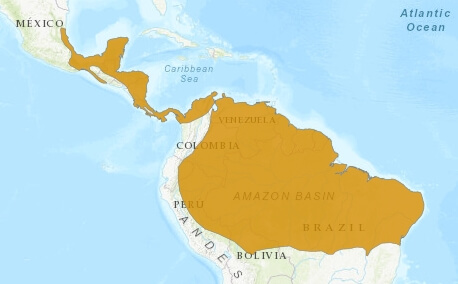Greater Grison
Galictis vittata
©Adriano Gambarini
Taxonomy
Standard English Name
Greater Grison
Scientific Name
Galictis vittata
Brazilian common name/s
Furão
Conservation status - IUCN
Physical Description
They are small animals, with a length of 50 to 70 cm and weigh 1 to 3 kg. G. vittata is slightly larger than G. cuja. The coat is very characteristic, with a black face, neck and limbs whereas the and back is gray. The boundary between the two colours is delineated by a white band that extends from the head to the side of the neck. They have very elongated body with short legs. These animals are extremely agile and are strong swimmers and climbers.
Ecology and Habitat
The geographical distribution of both species of this genus is still unclear. G. vittata occurs mainly in the north of Brazil, but the southern limits of its range have yet to be defined. G. cuja occurs in the central-southern part of the continent and north-east Brazil. G. vittata inhabits forests and open areas, including secondary habitats, living in tree trunks or rocks, in burrows that they dig. They are active both day and night and are often seen in pairs or small groups (probably families), who communicate through vocalizations.
Their diet includes small mammals, birds and their eggs, reptiles, amphibians, insects and fruit.
Online links
IUCN redlist (http://www.iucnredlist.org) presents a synthesis of current knowledge about distribution and conservation status.
References
Emmons, L. H., & Feer, F. (1997). Neotropical rainforest mammals: a field guide. Chicago: University of Chicago Press.
Michalski, F., & Peres, C. A. (2005). Anthropogenic determinants of primate and carnivore local extinctions in a fragmented forest landscape of southern Amazonia. Biological Conservation, 124, 383-396.
Sunquist, M. E., Sunquist, F., & Daneke, D. E. (1989). Ecological separation in a Venezuelan llanos carnivore community. In K. H. Redford & J. F. Eisenberg (Eds.), Advances in Neotropical mammalogy (pp. 197–232). Gainesville, Florida: Sandhill Crane Press.
Yensen, E., & Tarifa, T. (2003). Galictis vittata. Mammalian Species, 727, 1-8.
